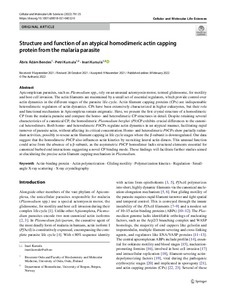Structure and function of an atypical homodimeric actin capping protein from the malaria parasite
Bendes Ábris Ádám; Kursula Petri; Kursula Inari
Structure and function of an atypical homodimeric actin capping protein from the malaria parasite
Bendes Ábris Ádám
Kursula Petri
Kursula Inari
SPRINGER BASEL AG
Julkaisun pysyvä osoite on:
https://urn.fi/URN:NBN:fi-fe2022091258696
https://urn.fi/URN:NBN:fi-fe2022091258696
Tiivistelmä
Apicomplexan parasites, such as Plasmodium spp., rely on an unusual actomyosin motor, termed glideosome, for motility and host cell invasion. The actin filaments are maintained by a small set of essential regulators, which provide control over actin dynamics in the different stages of the parasite life cycle. Actin filament capping proteins (CPs) are indispensable heterodimeric regulators of actin dynamics. CPs have been extensively characterized in higher eukaryotes, but their role and functional mechanism in Apicomplexa remain enigmatic. Here, we present the first crystal structure of a homodimeric CP from the malaria parasite and compare the homo- and heterodimeric CP structures in detail. Despite retaining several characteristics of a canonical CP, the homodimeric Plasmodium berghei (Pb)CP exhibits crucial differences to the canonical heterodimers. Both homo- and heterodimeric PbCPs regulate actin dynamics in an atypical manner, facilitating rapid turnover of parasite actin, without affecting its critical concentration. Homo- and heterodimeric PbCPs show partially redundant activities, possibly to rescue actin filament capping in life cycle stages where the beta-subunit is downregulated. Our data suggest that the homodimeric PbCP also influences actin kinetics by recruiting lateral actin dimers. This unusual function could arise from the absence of a beta-subunit, as the asymmetric PbCP homodimer lacks structural elements essential for canonical barbed end interactions suggesting a novel CP binding mode. These findings will facilitate further studies aimed at elucidating the precise actin filament capping mechanism in Plasmodium.
Kokoelmat
- Rinnakkaistallenteet [19207]
